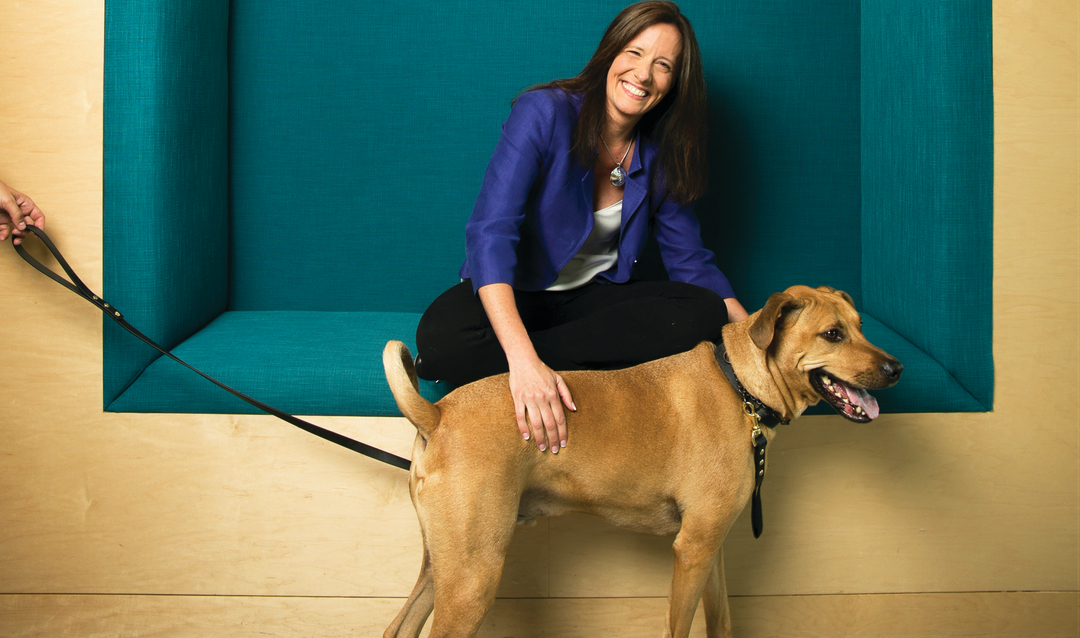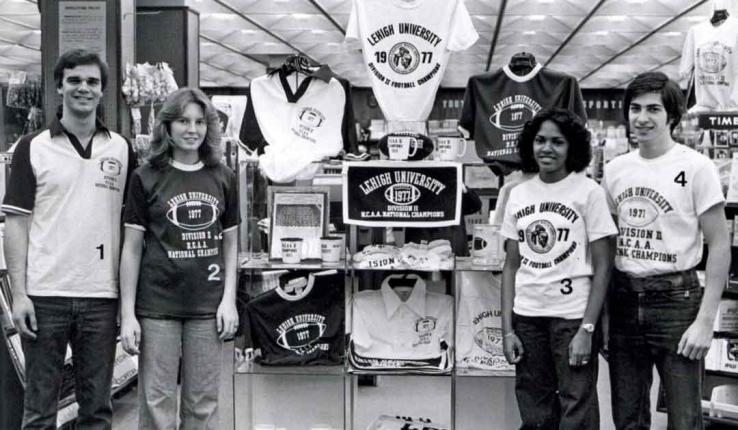Scores of Amazon employees—many with dogs in tow—stream up the stairs and escalators and then through the wide second-floor lobby of the tech giant’s Doppler tower in downtown Seattle. It’s a Monday morning in June, and a World Cup match is playing on a large screen in one of the building’s common areas as employees head to their desks and workspaces.
This is part of Amazon’s corporate headquarters, a cluster of buildings in the heart of downtown where dogs are aplenty, dress is casual and employees are encouraged to think big, dive deep, invent and simplify—all elements of the company’s 14 leadership principles.
“We’re always trying to do something new, build something new,” says Beth (Nussbaum) Galetti ’93, senior vice president of human resources at Amazon, explaining the company’s “Day One” culture. “To me, this company feels like you’re working at a place of a thousand startups. And we want to empower our employees at the frontline to invent on behalf of our customers.”
Along the blocks-long corporate campus, where more than 45,000 employees work, the “thinking big” part is apparent—from the Amazon Go convenience store (no checkout lines or cashiers), to the community banana stands (thousands of bananas are given out free each day as healthy snacks), to the giant metal-and-glass Spheres that opened in January (domed work areas that boast more than 40,000 plants and a 50-foot ficus tree nicknamed Rubi).
Here in the Doppler building—so named as a nod to the internal codeword for the Amazon Echo voice-controlled speaker launched in 2014—Galetti keeps a corner office that’s small and utilitarian, a modest 10-by-8-foot space seven floors up from the lobby with a stand-up computer desk, small table and a few family photos. Though she and her team will soon move to a similar space in a nearby building, the office, as it is now with her name handwritten in marker on a whiteboard, belies the scope of Galetti’s influence at the company.
In her senior leadership role, Galetti manages the recruitment, growth and development of Amazon’s 560,000-plus global workforce—one of the largest and fastest-growing workforces in the tech industry. She is currently the only woman on founder Jeff Bezos’ so-called S-team, a group of 19 senior executives, and has input into the company’s most important decisions. Earlier this year, when Amazon announced with fellow titans JPMorgan Chase and Berkshire Hathaway a new health care venture to address rising health care costs, Galetti was tapped to serve as Amazon’s leader for the partnership.
That Galetti would soar to such heights professionally should not surprise anyone who knew her at Lehigh, where she was president of the Society of Women Engineers and a teaching assistant. Excelling in math, she had left high school in Maryland early—at age 16—to come to Lehigh, where she would pursue her degree in electrical engineering.
“I can’t thank Lehigh enough for taking a chance on me like that,” Galetti says, reflecting on her early admission. “It launched me. And as a young person, I was anxious to launch.”
After graduation, Galetti went on to work for MCI Telecommunications Corp., and then FedEx, where relatively early in her career, she took on the responsibility of managing software development for the company’s package tracking system. In 2013, she joined Amazon.
She spoke with the Bulletin at Amazon headquarters in mid-June.
You’ve been tasked with what seems to be an enormous challenge—a new health care partnership with JPMorgan CHASE and Berkshire Hathaway that would address health care for your U.S. employees, with the aim of improving employee satisfaction and reducing costs. Why take on such a daunting challenge?
At Amazon, we believe in customer obsession—and thinking really big about tough problems. We know that this is a problem that’s really important to our employees and their families, and when the three CEOs—Warren Buffett of Berkshire Hathaway, Jamie Dimon of JPMorgan Chase, and Jeff Bezos of Amazon—got together, they talked about how we might partner to help our employees in this.
So it is in the very, very early stages. The idea is, we’re setting this up as an independent not-for-profit company. The goal will be to improve employee satisfaction and employee health outcomes. We think by doing those two things, there’s an opportunity to potentially also reduce costs. By setting it up in that way, we’re hopeful that we may have an impact. We recognize that this is really, really hard. There are many people who have tried to invent in this space in the past. We hope to learn from them. We hope to partner with many, and we hope to bring the three companies’ support to this independent company and see what we can do.
Editor’s note: The CEO of the new health care company, Dr. Atul Gawande, was announced in June 2018.
You graduated from Lehigh with a degree in electrical engineering in 1993, a year before Jeff Bezos founded Amazon. What had led you to Lehigh?
I was interested in Lehigh because it had such a great reputation as an engineering school. When I was young, my strengths were in math and science, and I really wanted to do something hard. Electrical engineering sounded exciting to me. My older brother is an electrical engineer, and he would tell me a lot about what he was doing. It sounded exciting, and it sounded very hard and very math-aligned, and I thought maybe I would have some strengths to bring to it. So I started looking at different engineering colleges. I fell in love with Lehigh because of the campus. The day we drove up, my parents and I, it was a beautiful fall day, couldn’t have been any better. The leaves were changing on the trees. And we met with an admissions counselor.We took a tour around the campus, and I was sold. It was definitely where I wanted to go.
I also had kind of a unique situation. The high school I went to tapped out at about Calculus 1, and because math had been my strong suit, I was able to complete that in my sophomore year. So I started attending math classes at [my local] community college and at the University of Maryland part-time. I visited Lehigh during the first half of my senior year, and I was telling the admissions counselor about what I was going through and how I was commuting to and from colleges and taking my classes, and I said, You know, I wish I could just go to college. He said, Well, would you come right away if you could?
I would, I said. I’d love to go. I was 16 years old. I was dying to get out on my own. The counselor said, Let’s talk about that a little bit. And sure enough, we worked out a way that Lehigh accepted me, technically a high school dropout at the time [laughter]. We worked out something with Lehigh and my high school, where I started Lehigh in the second semester [of the 1989-1990 academic year], in what would have been my senior year of high school.







